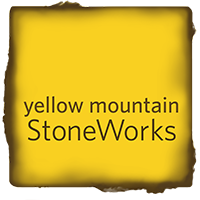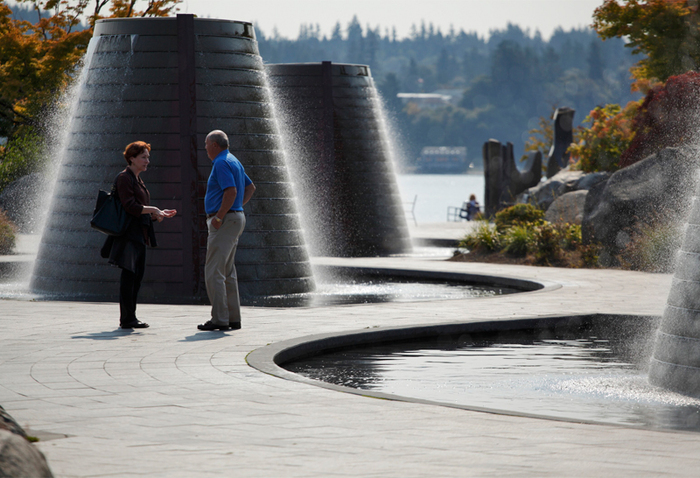Some people talk to trees, some talk to their cars; sculptor Paul Keeslar talks to stone ― and the stone talks back.
For the past 30+ years, artist Paul Keeslar has been communing with stone – and the results are stunning and varied. Sculptures include large and small, abstract and representative pieces that share a profound, universal beauty. His architectural stone work comprises traditional and contemporary interior and exterior architectural elements, landscapes, and restoration. On a current project for the University of Puget Sound, Paul is adding multiple stone elements like archways, benches, and window surrounds to create an aesthetic bridge between old and new buildings.
Paul’s expertise in stone is so extensive he is regularly called to consult on unique and challenging projects; that was how we met him. When we realized recently that Paul’s talents go far beyond architectural stone work, we invited ourselves to his studio and had a remarkable conversation about creativity, craft, and the seductive power of stone.
YM: How did you discover your passion for working with stone?
PK: Well when I was a young boy, I used to collect cool rocks, fossils and stuff; I was fascinated by them. I used to go out in the fields and just find things and bring them home.
YM: (laughs) I have a great vision of your boyhood bedroom.
PK: Exactly! My mom was always pulling her hair out about my growing collections.
YM: Did you study art in school?
PK: In high school I was interested in science and math; I was really good in math, which is handy on my architectural projects. I started taking art classes in college and really liked it, so I transferred to the School of the Art Institute of Chicago where I got my BFA. During that same time, I took my first sculpting class at the Blackhawk Mountain School of Art in Colorado. I just fell in love with it. Thirty years later, I’m still in love.
YM: What is about stone do you think, that continues to hold you?
PK: It’s the timeless quality of it. To be able to manipulate a piece of stone that’s been around for millions of years is captivating to me.
YM: There is so much history captured in stone, and stories that are revealed as you work with it.
PK: Absolutely. It’s different than working with wood or metal, or plaster or concrete. Stone is so intimate and inviting.
YM: And tactile. It makes you want to touch it, to connect with it.
PK: Yes, especially when you create different kinds of textures. I think about that when I’m creating a piece, because I want people to feel that pull.
YM: Do you start with a vision of what you want to create and then get the stone, or do you get the stone first?
PK: When I’m doing sculptures for myself that I’ll sell later, I usually work with stone I have, or I’ll buy a raw piece. Then I set it up and just observe it for however long it takes before something starts to develop within my mind. Or until something is dictated to me from the stone; it will start to communicate its essence to me, although sometimes it takes a couple of whacks of the hammer…you know…
YM: …to say, “Talk to me.”
PK: Yeah, exactly. “Hello? It’s been six weeks, say something. Anybody in there?” Allowing the spirit of the stone to be set free and then to let that essence take hold of you in its simplistic ideals is what I struggle to achieve in the creative process.
YM: Who or what has influenced you along your creative path?
PK: Foremost I’d have to say my dad, Cliff Kesslar. He has been an artist and designer my whole life and I’ve been hugely influenced by his art and his discipline. He creates beautiful, paper sculptures using a technique he developed where he builds layer upon layer of paper and creates the illusion of a three-dimensional space. It’s very dramatic, and he has been very successful at it. I’ve also always been influenced by Michelangelo and Leonardo Da Vinci. And I enjoy more contemporary artists like Constantin Brâncuși and Isamu Noguchi.
YM: Most of Brancusi’s work was in the first part of the 20th century and Noguchi began finding fame mid-century. Is there a next generation of sculptors?
PK: Not in any great number. I remember when I first got into stone thinking, this is such a cool medium for expression, and it’s barely known among my contemporaries. At the time, there were people doing stone countertops and such, but there wasn’t the stone art that used to exist. And I really wanted to bring that back. That’s one of the reasons I teach.
YM: Are the techniques much the same as they were in Michelangelo’s age?
PK: For the most part, yes. Sculpting is as much about learning patience as it is techniques. It’s putting your mind into it and then having the patience to allow the piece to come forward slowly. I usually teach hands-on only for the first couple of years; it’s hammer and chisel…and a lot of elbow grease. But the student will learn patience, they’ll learn technique, they’ll learn mind to hand coordination… and then control. And if they stick with it, ultimately they’ll find their own artistic expression.
YM: How did you get into architectural stone work?
PK: When I first moved out here from Michigan, it took a while to start selling my artwork so to make ends meet I was doing some construction work. And then I met a guy in town here that had a stone business doing exterior and interior architectural stone work. He was looking for somebody to do all the carving for him. I decided I’d give it a shot and I worked for him for about five years just getting to know everything about the trade.
YM: Similar to an apprenticeship?
PK: Yes. We built fountains, bridges, archways and all kinds of stuff. It was great experience, and to make a long story short, he ending up leaving town and since there was clearly a need I decided to take over the business. I said to the clients, “I’ll help you guys out, you know, if you can help me get started,” and it worked out just great.
YM: Do you find it challenging to balance your artwork with the architectural stone work?
PK: I consider it all to be artwork…for the most part. The sculptures engage my brain differently in terms of communing with a stone in order to express its essence. But I’ve worked on some amazingly creative architectural projects that have really challenged me. For example, I did a cylindrical fireplace with an elliptical opening in white marble and a large stone door with no visible hardware that you can open with the push of a finger, like it weighs nothing – that was super cool!
YM: What’s the main difference for you between sculpting and the architectural work?
PK: (laughs) There is a lot more collaboration required on the architectural projects.
YM: Ha, that’s true. We’ve found that it’s best to get involved as early as possible. That way we can understand the goals of the project and make recommendations on the stone, fabrication and installation techniques that will work best.
PK: Definitely. Everyone has their area of expertise, and if you can leverage that across any given project, it usually results in a smoother process and the best possible outcome.
YM: Your work is so varied – not only between the architectural work and the sculptures, but you’re also working in bronze, wood, stained glass and combining elements as well.
PK: It’s exciting delving into new materials and trying my hand at new things…even if I’ve never done it before. It’s always nice being able to take a risk, or more to the point, to not be afraid to take a risk.
YM: You have to give yourself permission to make mistakes.
PK: Precisely. That’s critical to the creative the process.
YM: I agree; so it makes me curious about what we are not seeing in all this beautiful artwork. Are there piles of broken stone that stand as evidence of directions you took that ultimately just didn’t work?
PK: Occasionally. I’ve rarely ever broken any stone, but I’ll change the design around completely and allow the stone to tell me something else that it wants me to make out of it. There was one time I was working on this big marble piece back in Michigan; I had all these ideas of what I wanted to do with it. I wanted to create a tropical rainforest with birds and stuff and I just got crazy with it. So I was carving out this head of a toucan bird and it was coming out great and then all of a sudden the whole nose breaks. After all that time carving that thing out and it just drops off, I was devastated. But eventually I thought, you know maybe that’s not what the stone wanted me to do with it. So I changed my whole perspective on that piece and I turned it into an abstract rather than something visually specific. It ended up being really cool and I sold it to an art collector in Michigan.
YM: When you’re doing your art, do you get lost in it? Do you look up and it’s tomorrow?
PK: All the time. When I’m doing my art for sure…and also when I’m doing architectural work that I really enjoy. To lose all track of time and just be so involved in what you’re doing is energizing and peaceful at the same time. It’s wonderful. It’s falling in love all over again.
To contact Paul Keeslar for more information, email pksculptor@yahoo.com


